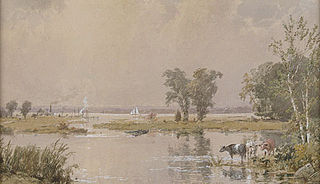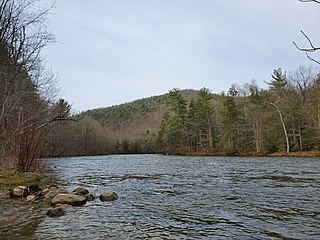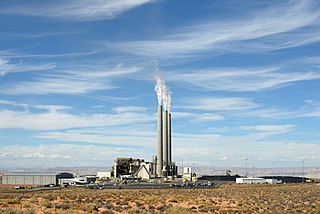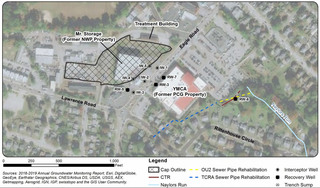
General Electric Company (GE) was an American multinational conglomerate founded in 1892, incorporated in the state of New York and headquartered in Boston. The company had several divisions, including aerospace, energy, healthcare, and finance.

Polychlorinated biphenyls (PCBs) are highly carcinogenic chemical compounds, formerly used in industrial and consumer products, whose production was banned in the United States by the Toxic Substances Control Act in 1976 and internationally by the Stockholm Convention on Persistent Organic Pollutants in 2001.

The Environmental Protection Agency (EPA) is an independent agency of the United States government tasked with environmental protection matters. President Richard Nixon proposed the establishment of EPA on July 9, 1970; it began operation on December 2, 1970, after Nixon signed an executive order. The order establishing the EPA was ratified by committee hearings in the House and Senate.

Pittsfield is the largest city and the county seat of Berkshire County, Massachusetts, United States. It is the principal city of the Pittsfield, Massachusetts Metropolitan Statistical Area which encompasses all of Berkshire County. Pittsfield’s population was 43,927 at the 2020 census. Although its population has declined in recent decades, Pittsfield remains the third-largest municipality in Western Massachusetts, behind only Springfield and Chicopee.

Brownfield is land that is abandoned or underutilized due to pollution from industrial use. The specific definition of brownfield land varies and is decided by policy makers and/or land developers within different countries. The main difference in definitions of whether a piece of land is considered a brownfield or not depends on the presence or absence of pollution. Overall, brownfield land is a site previously developed for industrial or commercial purposes and thus requires further development before reuse.

Industrial waste is the waste produced by industrial activity which includes any material that is rendered useless during a manufacturing process such as that of factories, mills, and mining operations. Types of industrial waste include dirt and gravel, masonry and concrete, scrap metal, oil, solvents, chemicals, scrap lumber, even vegetable matter from restaurants. Industrial waste may be solid, semi-solid or liquid in form. It may be hazardous waste or non-hazardous waste. Industrial waste may pollute the nearby soil or adjacent water bodies, and can contaminate groundwater, lakes, streams, rivers or coastal waters. Industrial waste is often mixed into municipal waste, making accurate assessments difficult. An estimate for the US goes as high as 7.6 billion tons of industrial waste produced annually, as of 2017. Most countries have enacted legislation to deal with the problem of industrial waste, but strictness and compliance regimes vary. Enforcement is always an issue.

New Jersey Meadowlands, also known as the Hackensack Meadowlands after the primary river flowing through it, is a general name for a large ecosystem of wetlands in northeastern New Jersey in the United States, a few miles to the west of New York City. During the 20th century, much of the Meadowlands area was urbanized, and it became known for being the site of large landfills and decades of environmental abuse. A variety of projects began in the late 20th century to restore and conserve the remaining ecological resources in the Meadowlands.

The Housatonic River is a river, approximately 149 miles (240 km) long, in western Massachusetts and western Connecticut in the United States. It flows south to southeast, and drains about 1,950 square miles (5,100 km2) of southwestern Connecticut into Long Island Sound.

ASARCO is a mining, smelting, and refining company based in Tucson, Arizona, which mines and processes primarily copper. The company has been a subsidiary of Grupo México since 1999.

The Hackensack River is a river, approximately 45 miles (72 km) long, in the U.S. states of New York and New Jersey, emptying into Newark Bay, a back chamber of New York Harbor. The watershed of the river includes part of the suburban area outside New York City just west of the lower Hudson River, which it roughly parallels, separated from it by the New Jersey Palisades. It also flows through and drains the New Jersey Meadowlands. The lower river, which is navigable as far as the city of Hackensack, is heavily industrialized and forms a commercial extension of Newark Bay.

Navajo Generating Station was a 2.25-gigawatt, coal-fired power plant located on the Navajo Nation, near Page, Arizona, United States. This plant provided electrical power to customers in Arizona, Nevada, and California. It also provided the power for pumping Colorado River water for the Central Arizona Project, supplying about 1.5 million acre feet (1.85 km3) of water annually to central and southern Arizona. As of 2017 permission to operate as a conventional coal-fired plant was anticipated until 2017–2019, and to December 22, 2044, if extended. However, in 2017, the utility operators of the power station voted to close the facility when the lease expires in 2019. In March 2019, the Navajo Nation ended efforts to buy the plant and continue running it after the lease expires.

In environmental law, the polluter pays principle is enacted to make the party responsible for producing pollution responsible for paying for the damage done to the natural environment. This principle has also been used to put the costs of pollution prevention on the polluter. It is regarded as a regional custom because of the strong support it has received in most Organisation for Economic Co-operation and Development (OECD) and European Union countries, and has a strong scientific basis in economics. It is a fundamental principle in US environmental law.

The Stratford Army Engine Plant (SAEP) was a U.S. Army Tank-Automotive and Armaments Command installation and manufacturing facility located in Stratford, Connecticut, where it was sited along the Housatonic River and Main Street, opposite Sikorsky Memorial Airport.

The Illinois Environmental Protection Agency of the state of Illinois is the primary body concerned with the protection of the environment for the state. The Illinois EPA's mission is "to safeguard environmental quality, consistent with the social and economic needs of the State, so as to protect health, welfare, property and the quality of life."

Havertown Superfund is a 13-acre polluted groundwater site in Havertown, Pennsylvania contaminated by the dumping of industrial waste by National Wood Preservers from 1947 to 1991. The state first became aware of the pollution in 1962 and initiated legal action against the owners in 1973 to force them to cleanup the site. The Environmental Protection Agency (EPA) ranked the site the eighth worst cleanup project in the United States. The site was added to the National Priorities List in 1983 and designated as a Superfund cleanup site in the early 1990s. Remediation and monitoring efforts are ongoing and the EPA transferred control of the site to the Pennsylvania Department of Environmental Protection in 2013.

The Clean Air Act (CAA) is the United States' primary federal air quality law, intended to reduce and control air pollution nationwide. Initially enacted in 1963 and amended many times since, it is one of the United States' first and most influential modern environmental laws.

An ash pond, also called a coal ash basin or surface impoundment, is an engineered structure used at coal-fired power stations for the disposal of two types of coal combustion products: bottom ash and fly ash. The pond is used as a landfill to prevent the release of ash into the atmosphere. Although the use of ash ponds in combination with air pollution controls decreases the amount of airborne pollutants, the structures pose serious health risks for the surrounding environment.

Between 1947 and 1977, General Electric polluted the Hudson River by discharging polychlorinated biphenyls (PCBs) causing a range of harmful effects to wildlife and people who eat fish from the river. Other kinds of pollution, including mercury contamination and cities discharging untreated sewage, have also caused problems in the river.

Silver Lake is a lake in Pittsfield, Massachusetts that has had environmental concerns and been subject to a clean-up effort by both the city of Pittsfield and the EPA.
Industrial stormwater is runoff from precipitation that lands on industrial sites. This runoff is often polluted by materials that are handled or stored on the sites, and the facilities are subject to regulations to control the discharges.




















